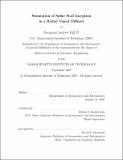Simulation of spike stall inception in a radial vanted diffuser
Author(s)
Hill, Raymond Andrew, IV
DownloadFull printable version (3.398Mb)
Other Contributors
Massachusetts Institute of Technology. Dept. of Aeronautics and Astronautics.
Advisor
Zoltan S. Spakovszky.
Terms of use
Metadata
Show full item recordAbstract
In turbocharger application bleed air at impeller exit is typically used to seal bearing compartments and to balance axial thrust in the rotor. It was previously shown that this bleed air can have a significant impact on both compressor performance and stability. Experiments suggest that spike stall inception in centrifugal compressors can be formed by a vaned diffuser. To address these issues, a numerical study on an advanced, vaned-diffuser centrifugal compressor was conducted to investigate stall inception. A steady three-dimensional Reynolds-averaged Navier-Stokes simulation using a mixing plane was carried out first to evaluate the effects of bleed air at impeller exit on stage and diffuser subcomponent performance. The steady simulation was compared with experimental measurements and did not show significant changes in stage and subcomponent performance due to leakage flow as observed in the experiments, indicating the importance of unsteady flow effects in the vaneless space and adjacent bleed cavity. Next, an unsteady three-dimensional Reynolds-averaged Navier-stokes simulation was carried out on four vaned diffuser passages to investigate the response of the diffuser flow field to short wavelength inlet disturbances in total pressure. The simulation employed a new approach, using circumferentially-averaged diffuser inlet conditions obtained from the steady stage simulation, eliminating the impeller and significantly reducing the computational time. This method was capable of simulating spike-like stall precursors rotating at 66% rotor speed which formed in response to inlet flow disturbances. The results represent a first numerical simulation of rotating spike-like flow disturbances in a radial vaned diffuser, and suggest that the spike stall precursors are formed by the vaned diffuser in absence of a tip leakage flow as it can occur in the rotors of axial compressors.
Description
Thesis (S.M.)--Massachusetts Institute of Technology, Dept. of Aeronautics and Astronautics, 2007. This electronic version was submitted by the student author. The certified thesis is available in the Institute Archives and Special Collections. Includes bibliographical references (p. 83-85).
Date issued
2007Department
Massachusetts Institute of Technology. Department of Aeronautics and AstronauticsPublisher
Massachusetts Institute of Technology
Keywords
Aeronautics and Astronautics.